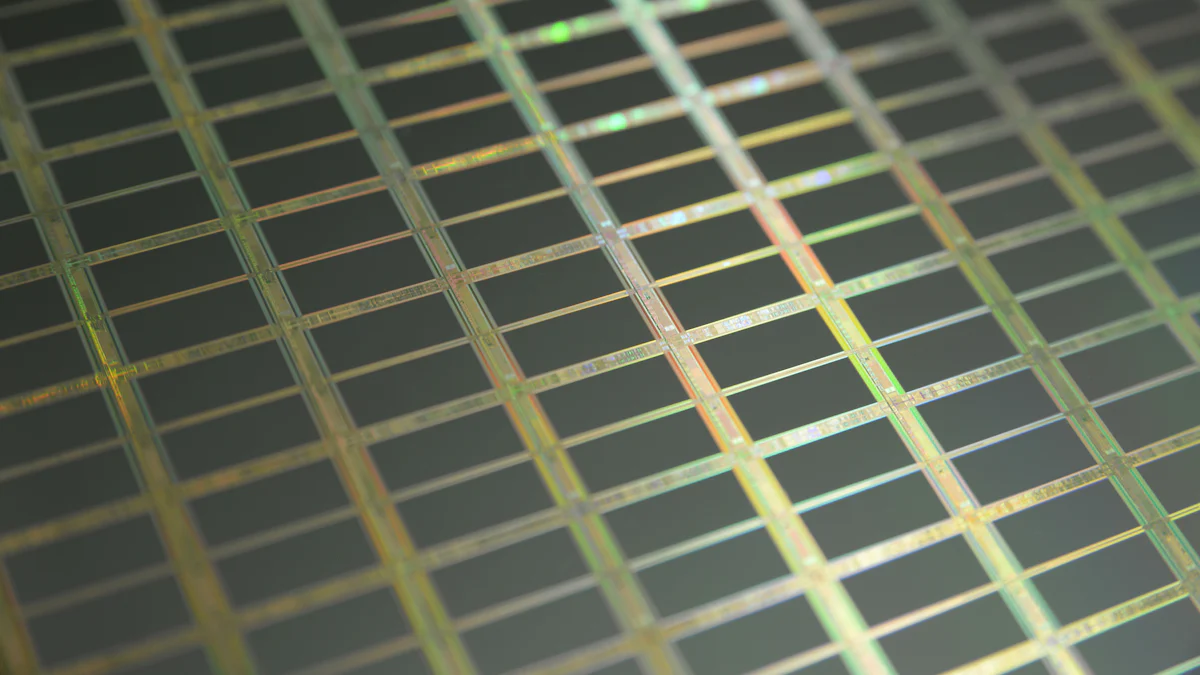Evaluating the Latest Trends in the Semiconductor Industry

The semiconductor industry plays a crucial role in modern technology. Rapid advancements drive innovation across various sectors, including consumer electronics and automotive industries. The industry's sales increased by 15.2% year-on-year in January 2024, indicating significant growth potential. This blog aims to evaluate the latest trends shaping the future of the semiconductor industry.
Technological Advancements in the Semiconductor Industry

Emerging Technologies in the Semiconductor Industry
AI and Machine Learning Integration
The integration of artificial intelligence (AI) and machine learning into the semiconductor industry has revolutionized computing. Semiconductor chips designed for AI applications enhance the processing and storage of complex algorithms. These chips reduce power consumption while maintaining performance robustness. This advancement drives innovation across various sectors, including consumer electronics and automotive industries.
AI technologies optimize supply chains and predict future demand. Companies leverage AI to manage inventory more efficiently. For example, Zunshida uses AI to dynamically manage inventory and provide real-time replenishment suggestions. This reduces costs and improves operational efficiency.
Quantum Computing
Quantum computing represents a significant leap forward for the semiconductor industry. Quantum computers use quantum bits or qubits, which can exist in multiple states simultaneously. This capability allows quantum computers to solve complex problems much faster than classical computers.
The development of quantum semiconductor chips enhances the power of AI applications. These chips enable faster data processing and more efficient problem-solving. The semiconductor industry benefits from the increased computational power provided by quantum computing.
Manufacturing Innovations in the Semiconductor Industry
Advanced Lithography Techniques
Advanced lithography techniques have transformed semiconductor manufacturing. Extreme ultraviolet (EUV) lithography allows for the creation of smaller and more powerful chips. This technique uses shorter wavelengths of light to etch finer patterns onto silicon wafers.
EUV lithography improves chip performance and reduces production costs. The semiconductor industry relies on these advanced techniques to meet the growing demand for high-performance chips. Companies investing in EUV technology gain a competitive edge in the market.
3D Chip Stacking
3D chip stacking is another innovation driving the semiconductor industry forward. This technique involves stacking multiple layers of chips on top of each other. The result is a more compact and efficient design.
3D chip stacking improves performance and reduces power consumption. This technique enables the creation of more powerful and energy-efficient devices. The semiconductor industry continues to explore new ways to implement 3D stacking in various applications.
Market Dynamics of the Semiconductor Industry
Supply Chain Challenges in the Semiconductor Industry
Global Chip Shortage
The global chip shortage has created significant disruptions in the semiconductor industry. Increased demand for electronic devices during the pandemic strained production capacities. Wafer foundries faced immense pressure to meet the rising requirements. The shortage impacted various sectors, including automotive and consumer electronics. Companies struggled to secure enough chips, leading to delays in product launches and reduced manufacturing output.
The shortage also affected commodity pricing and distribution. Prices for semiconductor components surged due to limited supply. Manufacturers had to navigate these challenges while maintaining production schedules. The semiconductor industry witnessed a ripple effect, with downstream industries experiencing delays and increased costs.
Geopolitical Factors
Geopolitical factors play a crucial role in the semiconductor industry's supply chain dynamics. Trade wars and geopolitical tensions have led to supply chain imbalances. Countries implemented policies to safeguard their semiconductor supply chains. For instance, the U.S. introduced bipartisan legislation to bolster competitiveness in the semiconductor industry. This move aimed to address severe supply chain disruptions and decrease dependency on foreign manufacturing.
The Russia-Ukraine conflict further exacerbated supply chain issues. The conflict impacted the supply of critical raw materials like neon and palladium. These materials are essential for semiconductor manufacturing. The industry had to adapt to these challenges by seeking alternative sources and diversifying supply chains.
Market Growth and Projections in the Semiconductor Industry
Key Market Players
Key market players drive growth and innovation in the semiconductor industry. Companies like Intel, Samsung, and TSMC lead the market with advanced technologies and significant investments. These companies focus on developing cutting-edge semiconductor solutions. Their efforts include research and development in AI, quantum computing, and 5G technologies.
Investments from key players ensure continuous advancements in semiconductor technology. These companies allocate substantial resources to enhance manufacturing processes and improve chip performance. Their contributions shape the future of the semiconductor industry, driving growth and competitiveness.
Future Market Trends
Future market trends indicate robust growth prospects for the semiconductor industry. The global market for semiconductors is projected to reach $1 trillion by 2030. This growth is driven by emerging technologies such as AI, Internet of Things (IoT), and autonomous vehicles. The demand for high-performance chips will continue to rise, fueling innovation and expansion.
Sustainability practices will also influence future trends. Companies are adopting eco-friendly manufacturing processes to reduce carbon footprints. The focus on sustainability aligns with global environmental goals. The semiconductor industry will play a pivotal role in advancing green technologies and promoting sustainable practices.
Applications and Impacts of the Semiconductor Industry

Consumer Electronics
Smartphones and Wearables
The semiconductor industry drives innovation in smartphones and wearables. Advanced semiconductor chips enhance processing power and battery efficiency. Consumers benefit from faster devices with longer battery life. Companies like Apple and Samsung invest heavily in semiconductor technology. These investments lead to groundbreaking features and improved user experiences.
Semiconductor advancements enable high-resolution displays and advanced cameras. Users enjoy clearer images and smoother video playback. Wearable devices, such as smartwatches, rely on efficient semiconductors. These devices monitor health metrics and provide real-time notifications. The integration of AI in semiconductors enhances the functionality of these gadgets.
Home Automation
Home automation relies on the semiconductor industry for smart devices. Semiconductors power smart thermostats, lighting systems, and security cameras. These devices communicate seamlessly within a smart home ecosystem. Users control their home environment remotely through mobile apps.
Smart home devices improve energy efficiency and security. Advanced semiconductors enable real-time data processing and decision-making. Companies like Google and Amazon lead the market with innovative smart home solutions. The demand for smart home technology continues to grow, driving further advancements in the semiconductor industry.
Automotive Industry
Electric Vehicles
Electric vehicles (EVs) depend on the semiconductor industry for efficient operation. Semiconductors manage battery systems and power electronics. These components optimize energy consumption and extend driving range. Companies like Tesla and General Motors invest in advanced semiconductor technologies. These investments result in more efficient and reliable EVs.
Semiconductor advancements reduce charging times and improve battery life. Consumers benefit from lower operating costs and reduced environmental impact. The push for sustainable transportation drives innovation in semiconductor technology. The automotive industry continues to evolve with the help of cutting-edge semiconductors.
Autonomous Driving
Autonomous driving technology relies heavily on the semiconductor industry. Semiconductors process vast amounts of data from sensors and cameras. These components enable real-time decision-making for autonomous vehicles. Companies like Waymo and NVIDIA lead the development of self-driving technology. Their efforts focus on creating safer and more efficient autonomous systems.
Advanced semiconductors enhance the accuracy and reliability of autonomous vehicles. These vehicles navigate complex environments with minimal human intervention. The integration of AI in semiconductors improves object recognition and path planning. The future of transportation will see increased adoption of autonomous driving, driven by semiconductor innovations.
Policy and Regulation in the Semiconductor Industry
Government Initiatives
Funding and Grants
Governments worldwide recognize the strategic importance of the semiconductor industry. The CHIPS Act and Science Act of 2022 exemplifies this recognition. The law allocates $52.7 billion in federal subsidies to support chip manufacturing in the United States. This substantial funding aims to revitalize the domestic semiconductor sector. The U.S. Commerce Department announced nearly $30 billion in grants and an additional $25 billion in loans. These financial incentives encourage companies to reassess their global strategies and invest in local production.
The US Innovation and Competition Act also bolsters the homegrown semiconductor industry. This act includes the CHIPS Act provisions, providing $52 billion in subsidies for domestic manufacturers. Such initiatives aim to reduce dependency on foreign suppliers and enhance national security. The generous tax breaks included in these acts further incentivize companies to expand their operations within the United States.
Trade Policies
Trade policies significantly impact the semiconductor industry's dynamics. Governments implement measures to protect and promote their domestic industries. The U.S. has introduced bipartisan legislation to address severe supply chain disruptions. These policies aim to decrease dependency on foreign manufacturing and ensure a steady supply of critical components.
Geopolitical tensions influence trade policies and, consequently, the semiconductor supply chain. The Russia-Ukraine conflict disrupted the supply of essential raw materials like neon and palladium. These materials are crucial for semiconductor manufacturing. Countries must navigate these challenges by diversifying their supply sources and implementing strategic trade policies.
Environmental Regulations
Sustainability Practices
Sustainability practices have become a focal point in the semiconductor industry. Companies adopt eco-friendly manufacturing processes to reduce their carbon footprints. These practices align with global environmental goals and promote long-term sustainability. Advanced technologies enable more efficient use of resources and energy. This efficiency reduces waste and minimizes the environmental impact of semiconductor production.
The push for sustainability drives innovation in green technologies. Companies invest in research and development to create more sustainable products. These efforts contribute to the overall reduction of greenhouse gas emissions. The semiconductor industry plays a pivotal role in advancing eco-friendly solutions.
E-Waste Management
E-waste management is another critical aspect of environmental regulation. The rapid advancement of technology leads to increased electronic waste. Proper disposal and recycling of e-waste are essential to mitigate environmental harm. Companies implement robust e-waste management programs to handle discarded electronic components responsibly.
Recycling initiatives recover valuable materials from e-waste, reducing the need for new raw materials. These programs help conserve natural resources and minimize landfill waste. Governments enforce regulations to ensure compliance with e-waste management standards. The semiconductor industry must adhere to these regulations to promote environmental sustainability.
The blog has covered several key trends shaping the semiconductor industry. Technological advancements, market dynamics, and policy changes drive continuous innovation. Staying updated with these trends is crucial for anyone involved in the industry.
Exploring more about these developments will provide valuable insights. The semiconductor industry impacts various sectors, making it essential to stay informed.
Call to Action: Share thoughts or get in touch for further discussion. Engaging with the community can lead to deeper understanding and new opportunities.
See Also
Insider Tips for Semiconductor Industry Quality Assurance
Revealing How Technology Shapes Market Trends
Collaborative Innovation for High-Tech Manufacturing Suppliers
Efficient Strategies for High-Tech Manufacturing Supply Chain Challenges
